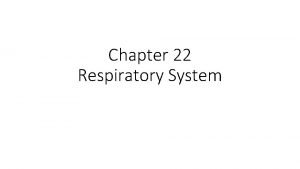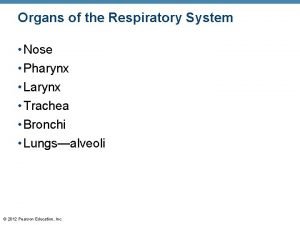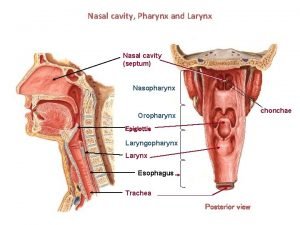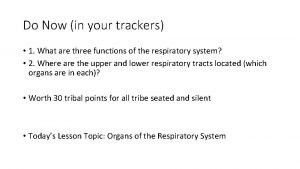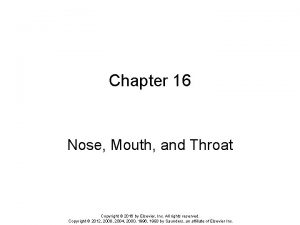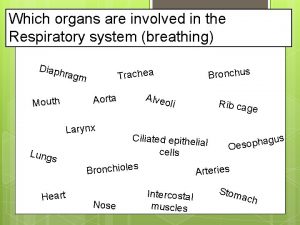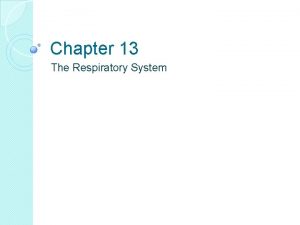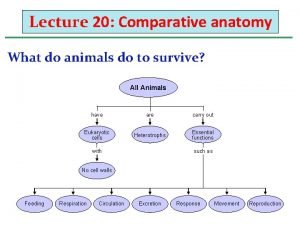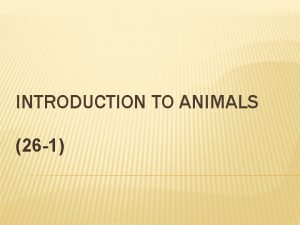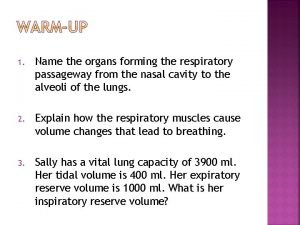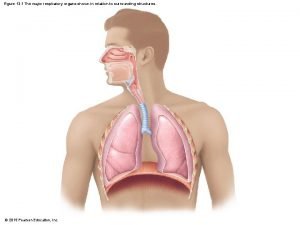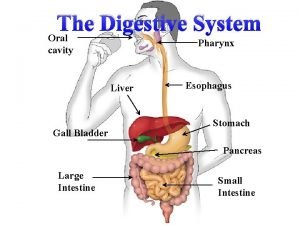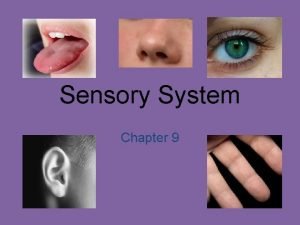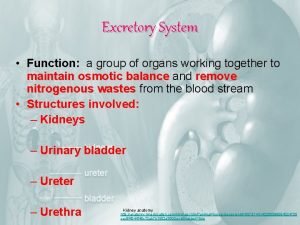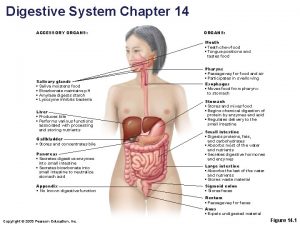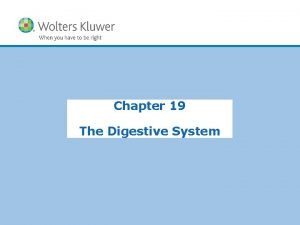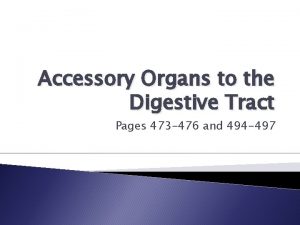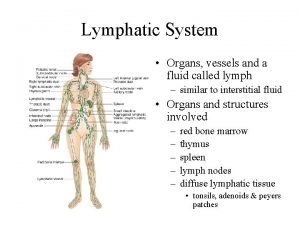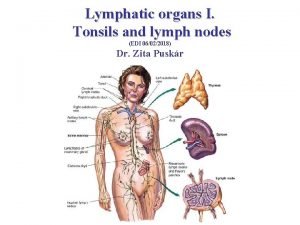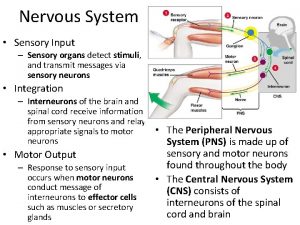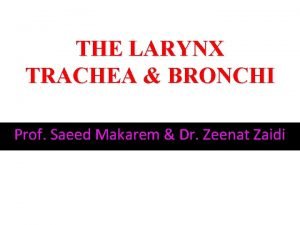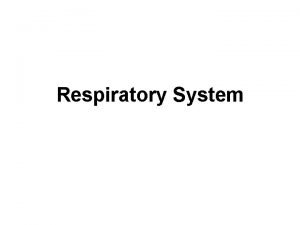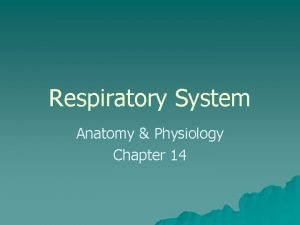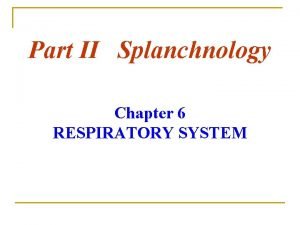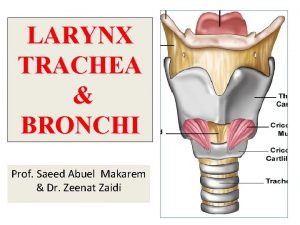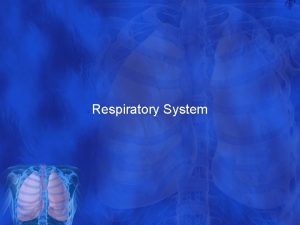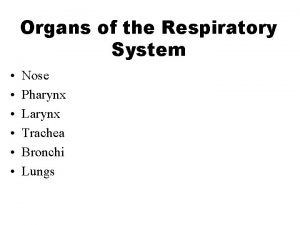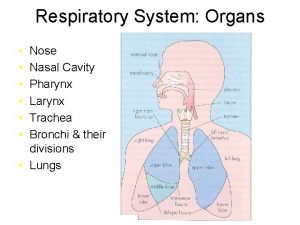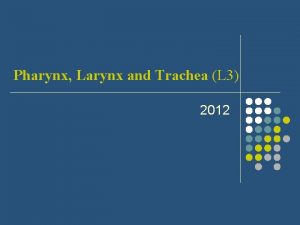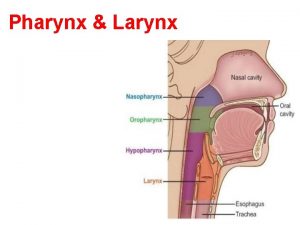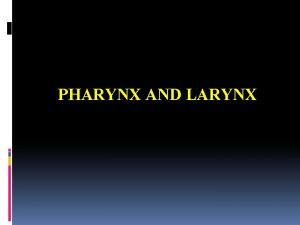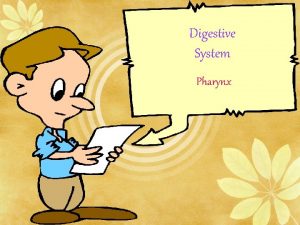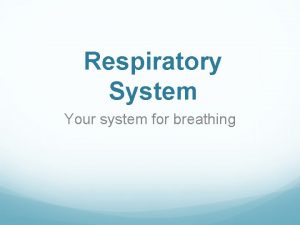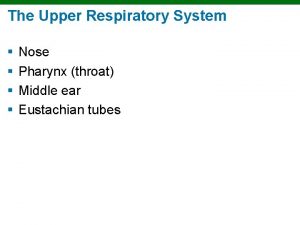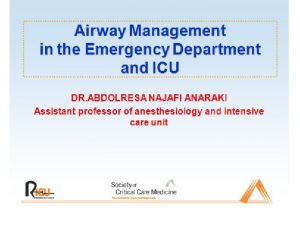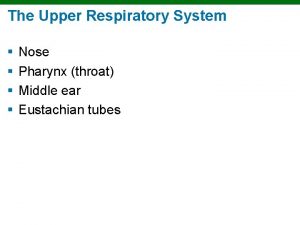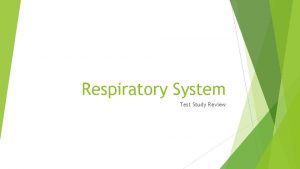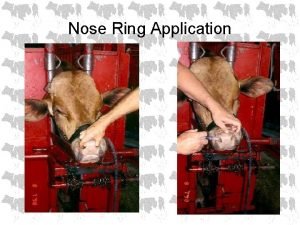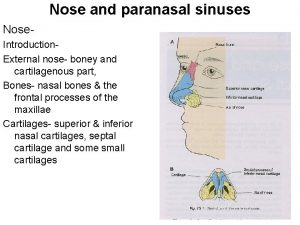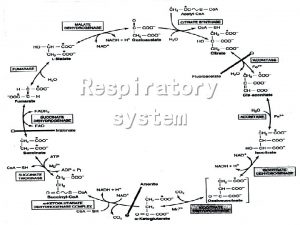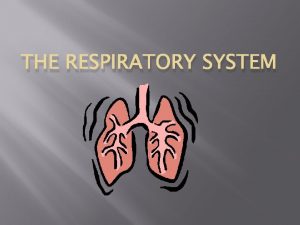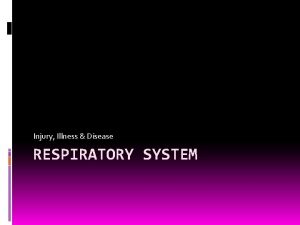Organs of the Respiratory system Nose Pharynx Larynx






































- Slides: 38

Organs of the Respiratory system § Nose § Pharynx § Larynx § Trachea § Bronchi § Lungs – alveoli Figure 13. 1

Function of the Respiratory System § Purify, warm, and humidify incoming air § Gas exchange – alveoli § Air enters through external nares (nostrils) § The interior of the nose consists of a nasal cavity divided by a nasal septum

Upper Respiratory Tract Figure 13. 2

Anatomy of the Nasal Cavity § Olfactory receptors on the superior surface § Cavity is lined with respiratory mucosa § Moistens/humidifies air § Traps incoming foreign particles § Lateral walls have conchae § Increase surface area & air turbulence § The nasal cavity is separated from the oral cavity by the hard (ant. ) and soft (post. ) palate

Paranasal Sinuses

Paranasal Sinuses § Cavities within bones surrounding the nasal cavity § Lighten skull § Resonance chambers for speech § Produce mucus - drains into the nasal cavity § Neti pot video

Larynx § Routes air and food into proper channels § Plays a role in speech § Made of eight rigid hyaline cartilages and a flap of elastic cartilage (epiglottis)

Structures of the Larynx § Thyroid cartilage § Protrudes anteriorly (Adam’s apple) § Vocal cords (vocal folds) § Vibrate with expelled air to create sound § Vid 1 Vid 2

Trachea (Windpipe) § Connects larynx with bronchi § Lined with ciliated cells § Beat continuously in the opposite direction of incoming air § Expel mucus loaded with dust and other debris away from lungs § Walls are reinforced with C-shaped hyaline cartilage

Trachea (Windpipe)

Primary Bronchi § Bronchi subdivide into smaller and smaller branches § 1 o (primary) bronchi § 2 o (secondary) bronchi § 3 o (tertiary) bronchi § Bronchioles § Terminal bronchioles

Respiratory Tree Divisions

Bronchioles § Smallest branches § Terminal bronchioles end in alveoli § Structure of alveoli § Alveolar sac § Alveolar duct § Alveolus § Gas exchange takes place within the alveolus

Alveoli § Simple squamous epithelium lines alveolar walls § Pulmonary capillaries cover external surfaces of alveoli

Respiratory Membrane (Air-Blood Barrier) Figure 13. 6

Gas Exchange § Gas diffuses across the respiratory membrane § O 2 enters the blood (from alveoli) § CO 2 enters the alveoli (from blood) § Macrophages in alveoli provide protection

Mechanics of Breathing § Completely mechanical process § Depends on volume changes in the thoracic cavity § Volume changes lead to pressure changes, which lead to the flow of gases to equalize pressure § Two phases § Inspiration – flow of air into lung § Expiration – air leaving lung

Inspiration § Diaphragm and intercostal muscles contract § The size of the thoracic cavity increases § External air is pulled into the lungs due to an increase in intrapulmonary volume (negative pressure)

Inspiration Figure 13. 7 a

Expiration § Largely a passive process § Depends on natural lung elasticity § As muscles relax, air is pushed out of the lungs § Forced expiration can occur mostly by contracting internal intercostal muscles to depress the rib cage (positive pressure)

Expiration Figure 13. 7 b

Respiratory Volumes and Capacities § Tidal volume (TV): Normal breathing moves about 500 ml of air with each breath § Factors that affect respiratory capacity § A person’s size, sex & age § Physical condition § Residual volume (RV): after exhalation, about 1200 ml of air remains in the lungs

Respiratory Capacities Figure 13. 9

Respiratory Volumes and Capacities § Inspiratory reserve volume (IRV) § Amount of air that can be taken in forcibly over the tidal volume § Usually between 2100 and 3200 ml § Expiratory reserve volume (ERV) § Amount of air that can be forcibly exhaled § Approximately 1200 ml

Respiratory Capacities Figure 13. 9

Respiratory Volumes and Capacities § Residual volume § Air remaining in lung after expiration § About 1200 ml

Respiratory Capacities Figure 13. 9

Respiratory Volumes and Capacities § Vital capacity § The total amount of exchangeable air § Vital capacity = TV + IRV + ERV § Dead space volume (Residual) § Air that remains in conducting zone and never reaches alveoli

Respiratory Volumes and Capacities § Functional volume § Air that actually reaches the respiratory zone § Respiratory capacities are measured with a spirometer

Respiratory Capacities Figure 13. 9

External and Internal Respiration External Respiration Internal Respiration TISSUE LUNGS Bloodstream (capillaries) Figure 13. 11

External Respiration (betw. lungs & blood) § Oxygen movement into the blood § The alveoli always has more oxygen than the blood § Oxygen moves by diffusion towards the area of lower concentration of oxygen § Pulmonary (lung) capillary blood gains oxygen

External Respiration (betw. lungs & blood) § Carbon dioxide movement out of the blood § Blood returning from tissues has higher concentrations of carbon dioxide than air in the alveoli § Pulmonary capillary blood gives up carbon dioxide (diffusion) § Blood leaving the lungs is oxygenrich and carbon dioxide-poor

Gas Transport in the Blood § Oxygen (O 2) transport in the blood § Inside red blood cells attached to hemoglobin (oxy-hemoglobin) § A small amount is carried dissolved in the plasma § Carbon dioxide (CO 2) transport in the blood § Most is transported in the plasma § A small amount is carried inside red blood cells on hemoglobin (but at different binding sites than those of oxygen)

Internal Respiration (betw. blood & tissue) § Exchange of gases between blood and body cells § The opposite of what occurs in the lungs § Carbon dioxide diffuses out of tissue to blood § Oxygen diffuses from blood into tissue

External and Internal Respiration External Respiration Internal Respiration TISSUE LUNGS Bloodstream (capillaries) Figure 13. 11

Neural Regulation of Respiration § respiratory muscles § phrenic nerve diaphragm § intercostal nerves intercostal muscles § Control center -- rate & depth – in medulla § Normal rate is 12– 15 breaths/min.

Factors Influencing Respiratory Rate and Depth § Physical factors § Increased body temperature § Exercise, Talking, Coughing § Volition (conscious control) § Emotional factors § Carbon dioxide levels § Oxygen levels
 Pharynx and larynx
Pharynx and larynx Development of respiratory system
Development of respiratory system Laryngopharynx
Laryngopharynx Pharynx and larynx and trachea
Pharynx and larynx and trachea What is larynx
What is larynx The cleft connecting the nose and mouth to the larynx
The cleft connecting the nose and mouth to the larynx Which organs are involved in respiratory system
Which organs are involved in respiratory system Respiratory system organs
Respiratory system organs The nose genre
The nose genre Nostril
Nostril Conducting zone of the respiratory system
Conducting zone of the respiratory system Respiratory organs of invertebrates
Respiratory organs of invertebrates Germ layers
Germ layers Organs forming the respiratory passageway
Organs forming the respiratory passageway Upper respiratory diagram
Upper respiratory diagram Figure 13-1
Figure 13-1 Respiratory system circulatory system digestive system
Respiratory system circulatory system digestive system Digestive system cavity
Digestive system cavity How respiratory system work with circulatory system
How respiratory system work with circulatory system Circulatory system and respiratory system work together
Circulatory system and respiratory system work together Sensory system organs
Sensory system organs What are the functions of excretory system
What are the functions of excretory system Mouth function in digestive system
Mouth function in digestive system Accessory organs of the digestive system
Accessory organs of the digestive system Accessory organs
Accessory organs Spleen function
Spleen function Lymphatic system organs
Lymphatic system organs Reticular cell
Reticular cell Largest lymphoid organ
Largest lymphoid organ Organs of the sensory system
Organs of the sensory system Chapter 16
Chapter 16 What is above the trachea
What is above the trachea Laryngeal surface of epiglottis
Laryngeal surface of epiglottis Lining epithelium of larynx
Lining epithelium of larynx Parts of the throat
Parts of the throat Description of the larynx
Description of the larynx Vestibule of larynx
Vestibule of larynx Larynx to trachea
Larynx to trachea Art cricothyroideus
Art cricothyroideus
